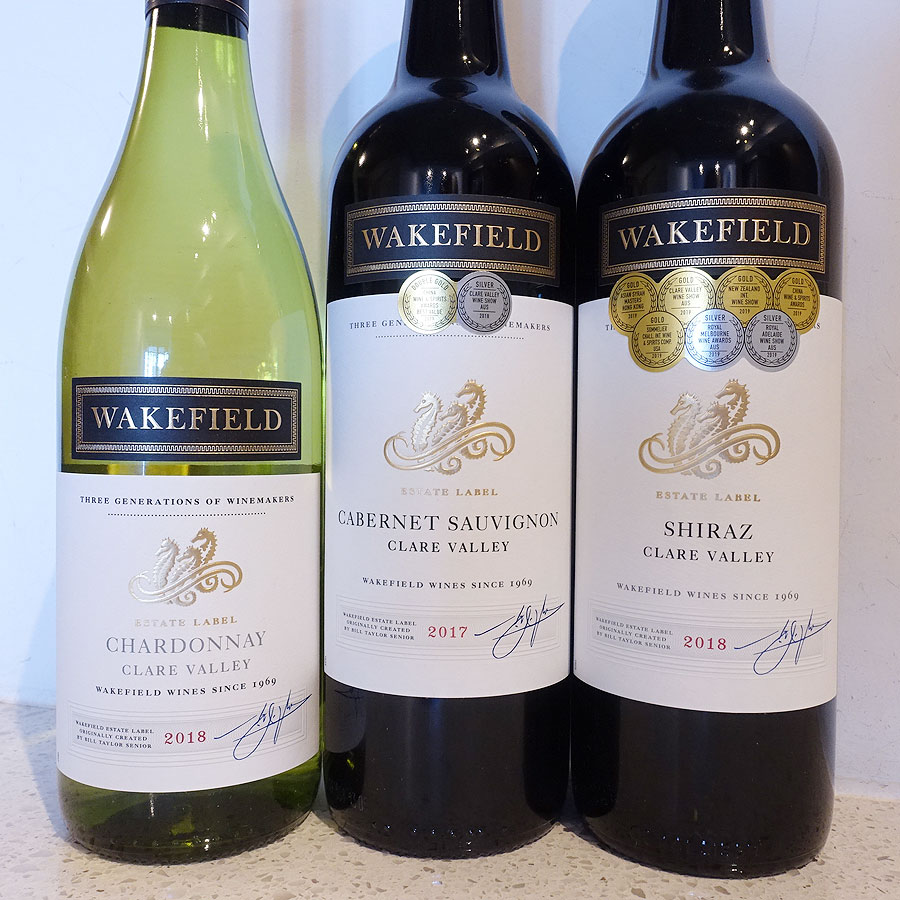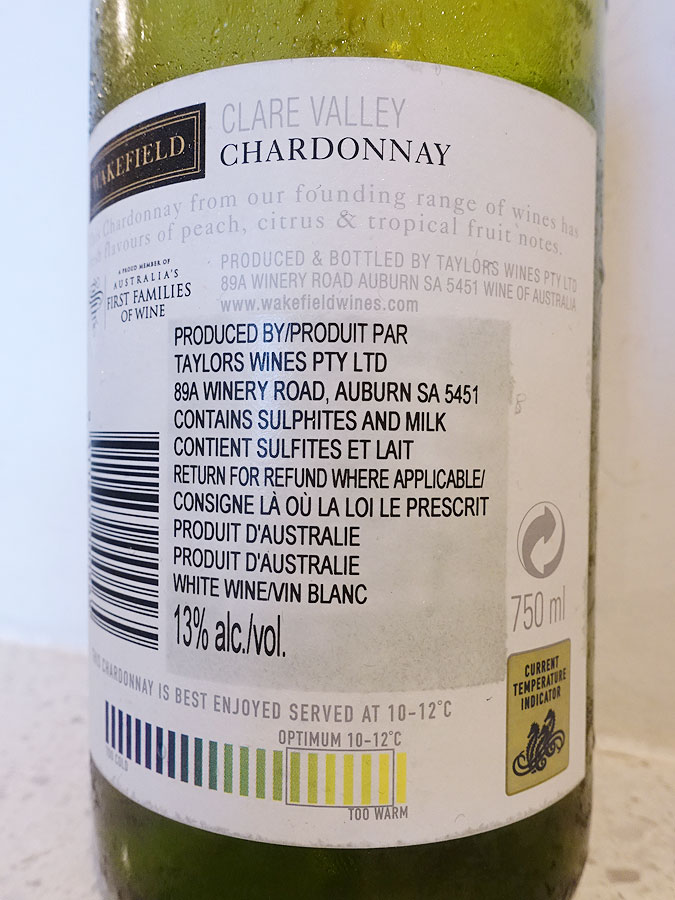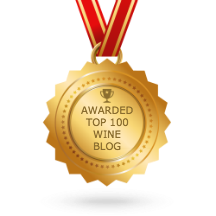wine reviews are a trio of wines from Australia's Wakefield Wines where we take brief look at wine serving temperatures.
But first, the story of Wakefield Wines begins in 1950, when the Taylor family's long-standing association with Clare Valley results in a partnership with a local co-operative to bottle and distribute their own wines. In 1969, Bill Taylor finds a perfect plot of land by the Wakefield River in South Australia's Clare Valley to establish their family estate and plants its first Cabernet Sauvignon vines. At the same time, Bill was excavating the land to find a water source and discovered tiny seahorses in the limestone bedrock that date back more than 600 million years. These seahorses are featured prominently in the company's logo.
In 1973, the Taylor family completed construction of the winery and also released their first wines - the Estate Cabernet Sauvignon and Estate Shiraz which are the heart of the business. As the company grew and expanded, they began exporting wines to the UK in 1985 under the name "Wakefield" due to international trademarks held by the Taylors family of Portugal. In 2004, Wakefield became the first major Australian wine company to bottle all of their wines under screw cap. The latest innovation came a few years ago, when they launched the Optimum Drinking Temperature sensor on the back label.
A world first, the back label of the Wakefield Estate and Promised Land range of wines feature their exclusive, touch-activated, Optimum Drinking Temperature sensor. The temperature of a wine plays an important role in the experience and enjoyment of wine. However, most people serve their wine without really thinking about the temperature of it and serve red wines at room temperature - which is too warm - and white wines too cold. The myth surrounding enjoying red wine at room temperature originated from the chilly drawing rooms of medieval French castles. In my younger days, I was also guilty of this behaviour as I would bring a nicely cooled red wine up from the basement and let it warm up to room temp before opening. I learned, and these days I chill all of my wines - how much time in the fridge depends on the varietal/style - and gradually let them warm up to see how the wine changes. I would strongly encourage you to try this at home as well.
Wakefield's solution to the temperature problem is to provide temperature sensors on the back label that indicate when the wine is ready to enjoy. Each wine has its own calibrated sensor that is touch-activated and changes colour depending on the temperature of the wine. By referencing the temperature guide (also printed on the back label) with the colour of the sensor, you can easily tell if the wine is too warm, too cold, or at the right serving temperature. Pictures of the back label are provided below, as well as wine reviews of three Wakefield Estate wines. Based on my personal experimentation, the temperature sensor is a useful guide that will help you determine when to drink the wine. However, since I tend to slowly sip my wines, I would serve them a little cooler than recommended and gradually let the wine warm up in the glass for best enjoyment.
All three of these wines are readily available in the VINTAGES section at the LCBO. Other wines from the Wakefield portfolio can be found at the LCBO or ordered via their Agent - Profile Wine Group.
Screw cap. Ripe, medium+ intensity nose has buttery, pear, golden apple, and some leesy aromas. It's medium-full bodied on the creamy palate with ripe banana and pineapple flavours balanced by apple, lemon, and sweet vanillin oak, and touches of butterscotch. Acids are fresh while the lemony, spicy finish has very good length. Arrived in LCBO VINTAGES . Score: 88 pts
WAKEFIELD ESTATE SHIRAZ 2018 - Clare Valley, South Australia (#943787) (XD) - $19.95
Screw cap. The medium-high intensity nose is fresh with herbal, leafy, mint and spice layered over black cherry, plum, and gentle oak aromas. The medium-full bodied palate offers well-integrated oak spice, black cherry, plum, and peppery spice flavours supported by smooth, fine-grained, and sweet tannins. It has fresh, juicy acidity. Pleasantly dry (but undeniably Shiraz) and well-balanced overall with a touch of chocolate on the long finish. VINTAGES Essentials product and always available year-round. The 2018 is a highly recommended buy! Score: 89 pts
WAKEFIELD ESTATE CABERNET SAUVIGNON 2017 - Clare Valley, South Australia (#744235) (XD) - $19.95
Screw cap. Fresh, medium-high intensity aromatics lead with herbal, green pepper, and black cherry liqueur followed by cassis, wood spice, and touches of olive. It is full-bodied on the palate with herbal, dark cherry, cassis, and woodsy replays on the flavour profile. Acids are well-balanced, while tannins are slightly chalky and grainy, softening somewhat since tasting in Sept. 2019. Earthy and wood spice notes linger on the finish, with good length. Available in LCBO VINTAGES now and also featured in the LCBO VINTAGES Release. Score: 88 pts
But first, the story of Wakefield Wines begins in 1950, when the Taylor family's long-standing association with Clare Valley results in a partnership with a local co-operative to bottle and distribute their own wines. In 1969, Bill Taylor finds a perfect plot of land by the Wakefield River in South Australia's Clare Valley to establish their family estate and plants its first Cabernet Sauvignon vines. At the same time, Bill was excavating the land to find a water source and discovered tiny seahorses in the limestone bedrock that date back more than 600 million years. These seahorses are featured prominently in the company's logo.
In 1973, the Taylor family completed construction of the winery and also released their first wines - the Estate Cabernet Sauvignon and Estate Shiraz which are the heart of the business. As the company grew and expanded, they began exporting wines to the UK in 1985 under the name "Wakefield" due to international trademarks held by the Taylors family of Portugal. In 2004, Wakefield became the first major Australian wine company to bottle all of their wines under screw cap. The latest innovation came a few years ago, when they launched the Optimum Drinking Temperature sensor on the back label.
A world first, the back label of the Wakefield Estate and Promised Land range of wines feature their exclusive, touch-activated, Optimum Drinking Temperature sensor. The temperature of a wine plays an important role in the experience and enjoyment of wine. However, most people serve their wine without really thinking about the temperature of it and serve red wines at room temperature - which is too warm - and white wines too cold. The myth surrounding enjoying red wine at room temperature originated from the chilly drawing rooms of medieval French castles. In my younger days, I was also guilty of this behaviour as I would bring a nicely cooled red wine up from the basement and let it warm up to room temp before opening. I learned, and these days I chill all of my wines - how much time in the fridge depends on the varietal/style - and gradually let them warm up to see how the wine changes. I would strongly encourage you to try this at home as well.
Wakefield's solution to the temperature problem is to provide temperature sensors on the back label that indicate when the wine is ready to enjoy. Each wine has its own calibrated sensor that is touch-activated and changes colour depending on the temperature of the wine. By referencing the temperature guide (also printed on the back label) with the colour of the sensor, you can easily tell if the wine is too warm, too cold, or at the right serving temperature. Pictures of the back label are provided below, as well as wine reviews of three Wakefield Estate wines. Based on my personal experimentation, the temperature sensor is a useful guide that will help you determine when to drink the wine. However, since I tend to slowly sip my wines, I would serve them a little cooler than recommended and gradually let the wine warm up in the glass for best enjoyment.
All three of these wines are readily available in the VINTAGES section at the LCBO. Other wines from the Wakefield portfolio can be found at the LCBO or ordered via their Agent - Profile Wine Group.
Tasting Notes:
WAKEFIELD CLARE VALLEY ESTATE CHARDONNAY 2018 - Clare Valley, South Australia (#711556) (XD) - $16.95Screw cap. Ripe, medium+ intensity nose has buttery, pear, golden apple, and some leesy aromas. It's medium-full bodied on the creamy palate with ripe banana and pineapple flavours balanced by apple, lemon, and sweet vanillin oak, and touches of butterscotch. Acids are fresh while the lemony, spicy finish has very good length. Arrived in LCBO VINTAGES . Score: 88 pts
WAKEFIELD ESTATE SHIRAZ 2018 - Clare Valley, South Australia (#943787) (XD) - $19.95
Screw cap. The medium-high intensity nose is fresh with herbal, leafy, mint and spice layered over black cherry, plum, and gentle oak aromas. The medium-full bodied palate offers well-integrated oak spice, black cherry, plum, and peppery spice flavours supported by smooth, fine-grained, and sweet tannins. It has fresh, juicy acidity. Pleasantly dry (but undeniably Shiraz) and well-balanced overall with a touch of chocolate on the long finish. VINTAGES Essentials product and always available year-round. The 2018 is a highly recommended buy! Score: 89 pts
WAKEFIELD ESTATE CABERNET SAUVIGNON 2017 - Clare Valley, South Australia (#744235) (XD) - $19.95
Screw cap. Fresh, medium-high intensity aromatics lead with herbal, green pepper, and black cherry liqueur followed by cassis, wood spice, and touches of olive. It is full-bodied on the palate with herbal, dark cherry, cassis, and woodsy replays on the flavour profile. Acids are well-balanced, while tannins are slightly chalky and grainy, softening somewhat since tasting in Sept. 2019. Earthy and wood spice notes linger on the finish, with good length. Available in LCBO VINTAGES now and also featured in the LCBO VINTAGES Release. Score: 88 pts


































